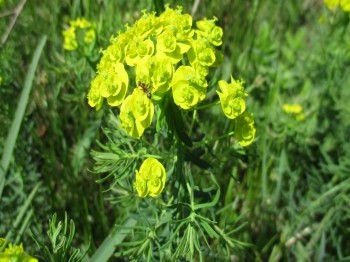Euphorbia laterifolia

|
|
Euphorbia lateriflora Common Names: Dwarf Spurge, Spotted Spurge,
Scutellann, Little Cactus Scientific
Classification Kingdom: Plantae Clade: Tracheophytes Clade: Angiosperms Clade: Eudicots Clade: Rosids Order: Malpighiales Family: Euphorbiaceae Genus: Euphorbia Species: E. lateriflora Binomial Name: Euphorbia lateriflora Schumach. & Thonn. Synonyms: Tithymalus lateriflorus (Schumach. & Thonn.) Klotzsch, Chamaesyce lateriflora (Schumach. & Thonn.) Small Morphological Description Euphorbia lateriflora is an annual or short-lived perennial herb, typically 10–30
cm tall, with a prostrate to ascending growth habit. Key features include: · Stems: Slender, hairy, reddish-green, 1–3 mm thick, branching from
the base, exuding milky latex · Leaves: Opposite, ovate to elliptic, 0.5–2 cm long, often
asymmetrical, green with reddish spots · Flowers: Small, 1–2 mm, greenish-white, in cyathial clusters,
subtended by glandular bracts · Fruit: Capsules, 2–3 mm, three-lobed, hairy, containing tiny
grayish seeds Its low, mat-forming
habit aids in weed-like spread (Flora of North America Editorial Committee,
2016). Distribution and Habitat Euphorbia lateriflora thrives in: · Native Range: Tropical West Africa (Nigeria, Ghana, Senegal) and parts of North
America (southern U.S., Mexico) · Introduced Range: Scattered in tropics and subtropics
globally · Habitat: Disturbed sites (lawns, gardens, roadsides), sandy or
gravelly soils; 0–1,000 m altitude · Climate: Warm, semi-arid to humid, 400–1,500 mm rainfall It’s a resilient weed in
agricultural and urban settings (CABI, 2023). Ethnopharmacology Euphorbia lateriflora, a member of the Euphorbiaceae family, is a
plant used in traditional African medicine for its diverse therapeutic
properties. It is primarily known for its antimicrobial, anti-inflammatory, and
analgesic effects. Traditionally, extracts from the plant, especially the latex
and leaves are used to treat skin infections, wounds, ulcers, toothaches, and
rheumatic pains. It is also employed as a laxative, emetic, and in some
cultures, to manage respiratory issues and fevers. The plant contains bioactive
compounds such as diterpenoids, flavonoids, and tannins, which contribute to
its pharmacological effects. However, like many Euphorbia species, it produces
a milky latex that is highly irritant and potentially toxic, especially to the
eyes and skin, requiring careful handling and precise dosage in traditional
use. Further scientific research is needed to validate its medicinal efficacy
and establish safe usage guidelines. · Snakebites/Scorpion Stings: West African topical remedy; reduces
inflammation in rats (40% at 150 mg/kg) (Mwine & Van Damme, 2011). · Wound Healing: Ghanaian application; antiseptic properties noted in vitro
(Ernst et al., 2015). · Purgative: Nigerian use of sap; laxative effect in small doses (PROTA,
2019). Its medicinal use is
less prominent than other Euphorbias; caution is advised due to irritant sap. Phytochemistry Limited specific studies
exist, but genus trends suggest: · Diterpenes: Ingenol types; cytotoxic, irritant (Shi et al., 2008). · Triterpenoids: β-Amyrin, euphol; anti-inflammatory (Mwine & Van Damme,
2011). · Flavonoids: Quercetin-like; antioxidant potential (Ernst et al., 2015). ⚠ Toxicity Profile: Latex irritates skin/eyes; ingestion causes
nausea, diarrhea (LD₅₀ ~2,000 mg/kg in rats) (Mwine & Van Damme, 2011). Additional Information · Weed Status: Invasive in lawns, reducing crop yields (e.g., 15% in maize)
(CABI, 2023). · Ecological Role: Colonizes bare soil, competes with natives
(Flora of North America Editorial Committee, 2016). · Cultural Note: Misidentified with ornamental Euphorbias like poinsettia
(PROTA, 2019). References
External Links More Pictures
|
|
| Compounds of Euphorbia laterifolia | |
| References |